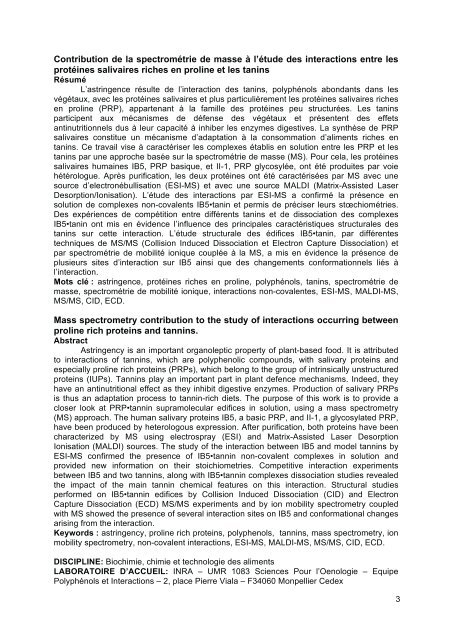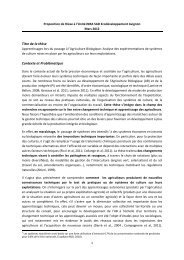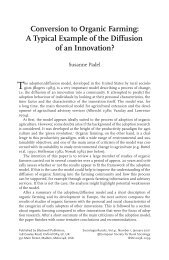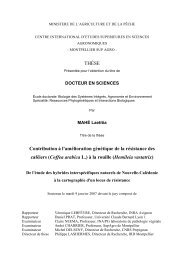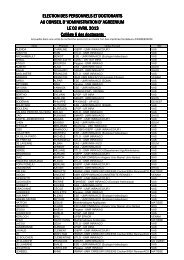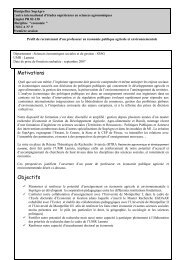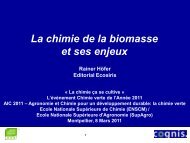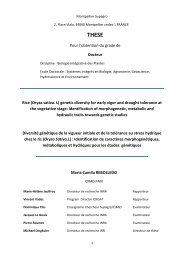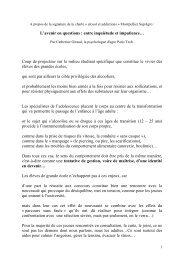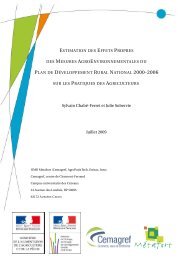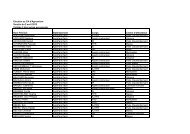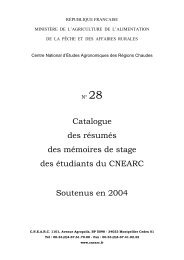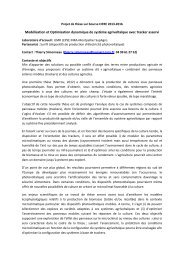Thèse Canon - Montpellier SupAgro
Thèse Canon - Montpellier SupAgro
Thèse Canon - Montpellier SupAgro
Create successful ePaper yourself
Turn your PDF publications into a flip-book with our unique Google optimized e-Paper software.
Contribution de la spectrométrie de masse à l’étude des interactions entre lesprotéines salivaires riches en proline et les taninsRésuméL’astringence résulte de l’interaction des tanins, polyphénols abondants dans lesvégétaux, avec les protéines salivaires et plus particulièrement les protéines salivaires richesen proline (PRP), appartenant à la famille des protéines peu structurées. Les taninsparticipent aux mécanismes de défense des végétaux et présentent des effetsantinutritionnels dus à leur capacité à inhiber les enzymes digestives. La synthèse de PRPsalivaires constitue un mécanisme d’adaptation à la consommation d’aliments riches entanins. Ce travail vise à caractériser les complexes établis en solution entre les PRP et lestanins par une approche basée sur la spectrométrie de masse (MS). Pour cela, les protéinessalivaires humaines IB5, PRP basique, et II-1, PRP glycosylée, ont été produites par voiehétérologue. Après purification, les deux protéines ont été caractérisées par MS avec unesource d’electronébullisation (ESI-MS) et avec une source MALDI (Matrix-Assisted LaserDesorption/Ionisation). L’étude des interactions par ESI-MS a confirmé la présence ensolution de complexes non-covalents IB5•tanin et permis de préciser leurs stœchiométries.Des expériences de compétition entre différents tanins et de dissociation des complexesIB5•tanin ont mis en évidence l’influence des principales caractéristiques structurales destanins sur cette interaction. L’étude structurale des édifices IB5•tanin, par différentestechniques de MS/MS (Collision Induced Dissociation et Electron Capture Dissociation) etpar spectrométrie de mobilité ionique couplée à la MS, a mis en évidence la présence deplusieurs sites d’interaction sur IB5 ainsi que des changements conformationnels liés àl’interaction.Mots clé : astringence, protéines riches en proline, polyphénols, tanins, spectrométrie demasse, spectrométrie de mobilité ionique, interactions non-covalentes, ESI-MS, MALDI-MS,MS/MS, CID, ECD.Mass spectrometry contribution to the study of interactions occurring betweenproline rich proteins and tannins.AbstractAstringency is an important organoleptic property of plant-based food. It is attributedto interactions of tannins, which are polyphenolic compounds, with salivary proteins andespecially proline rich proteins (PRPs), which belong to the group of intrinsically unstructuredproteins (IUPs). Tannins play an important part in plant defence mechanisms. Indeed, theyhave an antinutritional effect as they inhibit digestive enzymes. Production of salivary PRPsis thus an adaptation process to tannin-rich diets. The purpose of this work is to provide acloser look at PRP•tannin supramolecular edifices in solution, using a mass spectrometry(MS) approach. The human salivary proteins IB5, a basic PRP, and II-1, a glycosylated PRP,have been produced by heterologous expression. After purification, both proteins have beencharacterized by MS using electrospray (ESI) and Matrix-Assisted Laser DesorptionIonisation (MALDI) sources. The study of the interaction between IB5 and model tannins byESI-MS confirmed the presence of IB5•tannin non-covalent complexes in solution andprovided new information on their stoichiometries. Competitive interaction experimentsbetween IB5 and two tannins, along with IB5•tannin complexes dissociation studies revealedthe impact of the main tannin chemical features on this interaction. Structural studiesperformed on IB5•tannin edifices by Collision Induced Dissociation (CID) and ElectronCapture Dissociation (ECD) MS/MS experiments and by ion mobility spectrometry coupledwith MS showed the presence of several interaction sites on IB5 and conformational changesarising from the interaction.Keywords : astringency, proline rich proteins, polyphenols, tannins, mass spectrometry, ionmobility spectrometry, non-covalent interactions, ESI-MS, MALDI-MS, MS/MS, CID, ECD.DISCIPLINE: Biochimie, chimie et technologie des alimentsLABORATOIRE D’ACCUEIL: INRA – UMR 1083 Sciences Pour l’Oenologie – EquipePolyphénols et Interactions – 2, place Pierre Viala – F34060 Monpellier Cedex3


